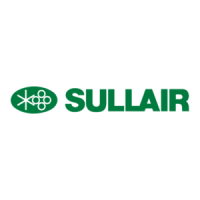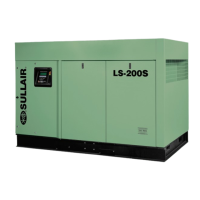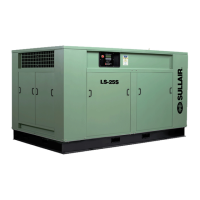Section 6
MAINTENANCE
26
Figure 6---7 Pressure Switch (P/N 040694)
2. Turn the range adjusting screw to the high pres-
sure setting. Turning thescrewcounterclockwise
lowers both the high and low pressure equally.
FOR DIFFERENTIAL ADJUSTMENT:
Differential is the difference between the high and
low pressure settings, 10 psig (0.7 bar) is typical.
Turn the differential adjusting screw tothe lower (re-
set) setting. Turning the screw counterclockwise
widens the differential by lowering the reset (lower)
setting only.
When the pressure switch adjustment is complete,
the pressure regulator should be adjusted for the
pressure at which modulation of air delivery should
begin. In this case, that pressure will be 100 psig
(6.9 bar). The regulator isadjusted by loosening the
jam nut on the end of the cone shaped cover of the
pressure regulator. With the jam nut loose, turn the
adjusting screw clockwise to increase or counter-
clockwise to decrease the setting.
Above 100psig (6.9 bar), the regulator should allow
pressure to flow into the control chamber of the Sul-
licon Control. The Sullicon Control lever should start
to move at this time.
Cycle the control system several times and recheck
all pressure settings.
6.8 TROUBLESHOOTING
The information contained in the Troubleshooting
chart has been compiled from field report data and
factory experience. It contains symptoms and usual
causes for the described problems. However
DO
NOT
assume that these are the only problems that
may occur. All available data concerning thetrouble
should besystematically analyzed before undertak-
ing any repairs or component replacement proce-
dures.
A detailed visual inspection is worth performing for
almost all problems and may avoid unnecessary
additional damage to the compressor. Always re-
member to:
1. Check for loose wiring.
2. Check for damaged piping.
3. Check for parts damaged by heat or an electrical
short circuit, usually apparent by discoloration or
a burnt odor.
Should your problem persist after making the rec-
ommended check, consult your nearest Sullair rep-
resentative or the Sullair Corporation factory .
TROUBLESHOOTING
SYMPTOM PROBABLE CAUSE REMEDY
COMPRESSOR WILL NOT START Main Disconnect Switch Open Close switch.
Line Fuse Blown Replace fuse.
Control Transformer Fuse Blown Replace fuse.
Motor Starter Overloads Tripped Reset. Should trouble persist, check
whether motor starter contacts are
functioning properly.
Low Incoming Line Voltage Check voltage. Should voltage check low,
consult power company.
COMPRESSOR SHUTS DOWN
WITH AIR DEMAND PRESENT Loss of Control Voltage Reset. If trouble persists, check that line
pressure does not exceed maximum oper---
ating pressure of the compressor (specified
on nameplate).

